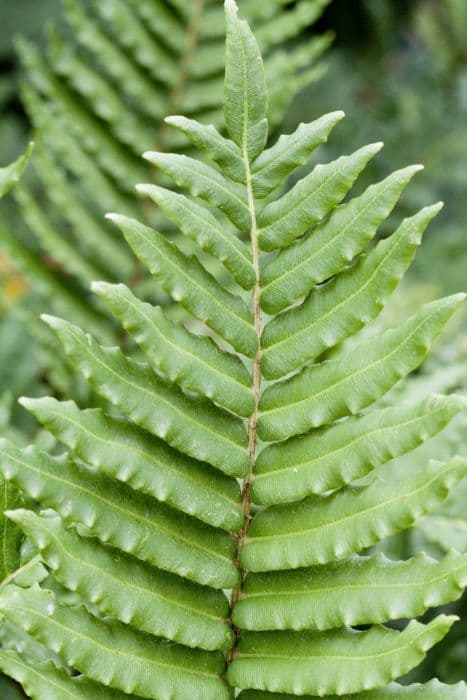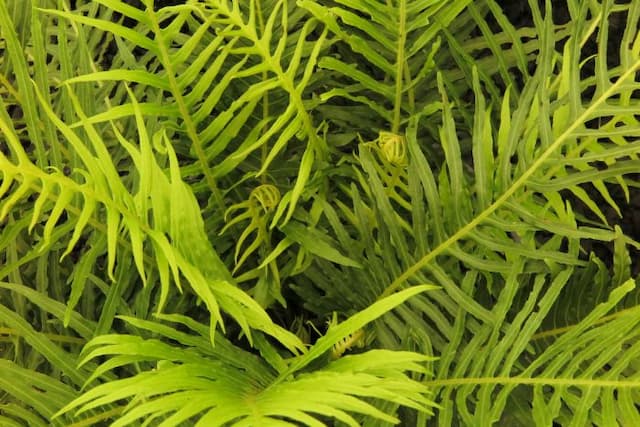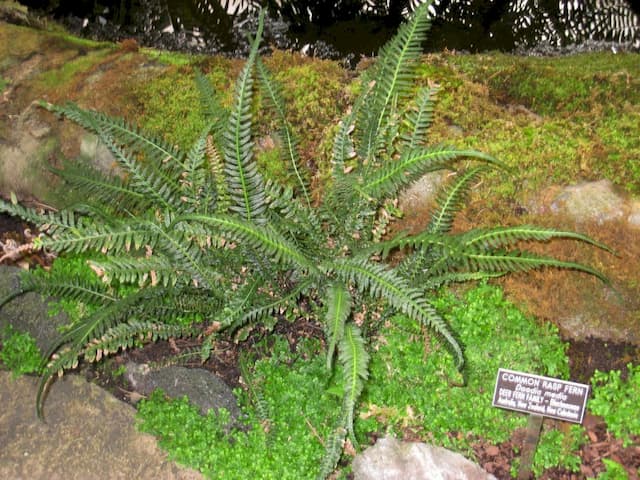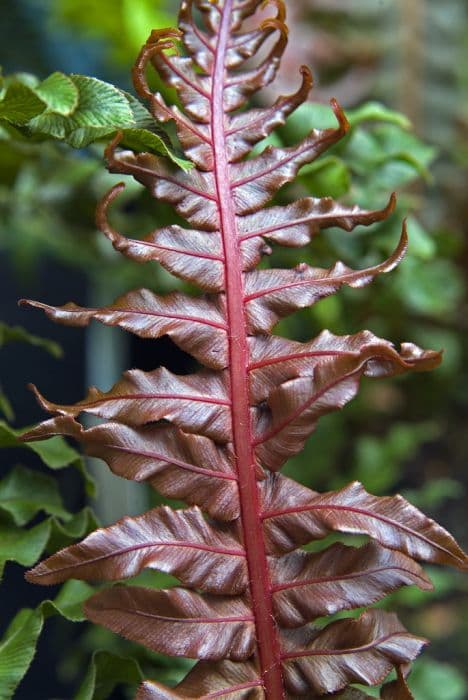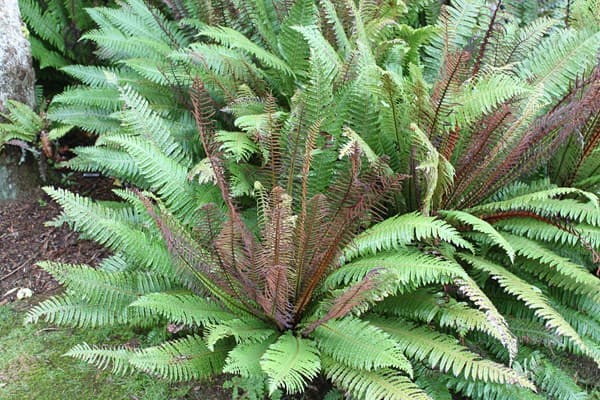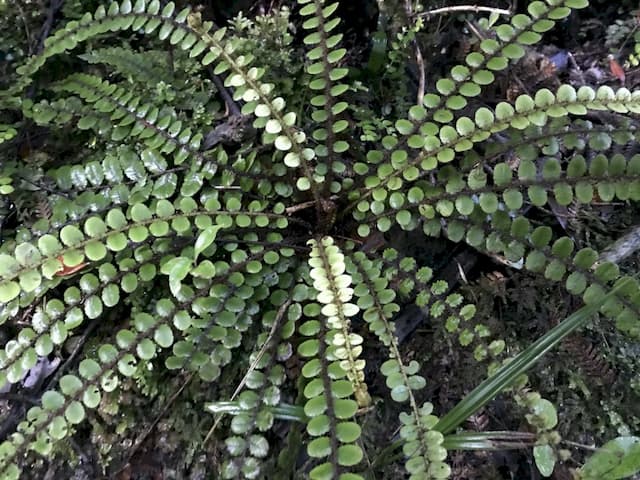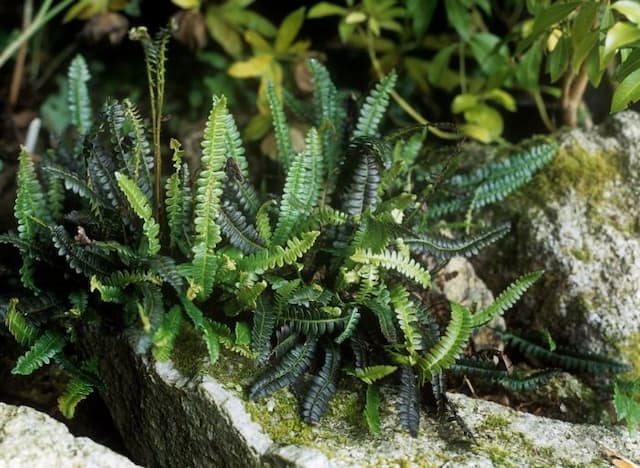Chain Fern Woodwardia radicans

ABOUT
The Chain fern is a lush perennial fern that displays broad, arching fronds which are rich green in color. As the plant matures, these fronds develop a unique and attractive appearance; The foliage is segmented into numerous smaller leaflets, creating a feathery look. Each leaflet has a smooth to slightly wavy margin, contributing to the frond's overall delicate texture. At the intersection where the leaflets meet the main stem, or the rachis, you may notice miniature plantlets forming, which is a distinctive feature of the Chain fern. These tiny replicas of the parent plant are equipped to root and grow into new ferns if given the opportunity. The backside of the leaflets often harbors spore cases, which are used for reproduction. The plant has a vigorous growth habit, forming a large, dense clump as it matures. It typically thrives in moist, shaded environments, echoing the ambiance of its natural woodland habitat. The striking fronds are not only long but also wide, which adds to the fullness of the plant's appearance. Overall, the Chain fern presents a lush, verdant presence in any garden or natural setting where it is found.
About this plant
 Names
NamesFamily
Blechnaceae
Synonyms
Chain Fern, European Chain Fern, Giant Chain Fern
Common names
Lorinseria radicans, Woodwardia speciosa
 Toxicity
ToxicityTo humans
Woodwardia radicans, commonly known as chain fern, is not typically listed as a toxic plant to humans. There is no widespread documentation of toxicity or poisonous reactions in humans due to ingestion or contact with the chain fern. As with many plants, it is generally advisable to avoid ingestion as standard precaution, but there are no specific symptoms of poisoning associated with this fern for humans since it is not considered hazardous.
To pets
Chain fern, or Woodwardia radicans, is also not known to be toxic to pets. There is no significant evidence that suggests the ingestion of any part of the chain fern leads to poisoning in animals such as cats or dogs. Nevertheless, it is always prudent to prevent pets from eating plants, as individual animals might have sensitivities or allergic reactions, and ingestion of non-food items can sometimes lead to gastrointestinal upset or blockage.
 Characteristics
CharacteristicsLife cycle
Perennials
Foliage type
Evergreen
Color of leaves
Green
Height
5 feet (1.5 meters)
Spread
3 feet (0.9 meters)
Plant type
Fern
Hardiness zones
8
Native area
Mediterranean
Benefits
 General Benefits
General Benefits- Erosion control: Woodwardia radicans, commonly known as Giant Chain Fern, has a robust root system which helps stabilize soil and prevent erosion.
- Habitat creation: It provides habitat and shelter for various small wildlife and insects.
- Aesthetic appeal: With its large, arching fronds, the Giant Chain Fern is often used in gardens and landscapes for visual interest.
- Shade tolerance: It can thrive in shaded areas where other plants might struggle, making it suitable for underplanting in wooded gardens.
- Soil enrichment: As ferns decompose, they contribute to the nutrient content of the soil, enriching it for other plant life.
- Humidity tolerance: This fern can tolerate and thrive in humid conditions, making it a good choice for certain climates.
- Low maintenance: Once established, the Giant Chain Fern requires minimal care beyond occasional watering and removal of dead fronds.
- Drought resistance: It can withstand periods of dryness once established, making it suitable for xeriscaping in mild climates.
 Medical Properties
Medical PropertiesThis plant is not used for medical purposes.
 Air-purifying Qualities
Air-purifying QualitiesThis plant is not specifically known for air purifying qualities.
 Other Uses
Other Uses- Chain Fern Rhizome Craft: Woodwardia radicans rhizomes have been used to weave durable baskets and mats due to their length and strength.
- Shade Garden Aesthetic: The Chain Fern's lush foliage is ideal for creating dense and shaded garden landscapes, providing a green backdrop for other shade-loving plants.
- Naturalizing Water Features: Planting Woodwardia radicans around ponds and streams can help achieve a natural, wild look, enhancing the aesthetic of water features.
- Erosion Control: The robust root system of the Chain Fern can help stabilize soil in areas prone to erosion, making it a practical choice for hillside planting.
- Fernery Displays: Due to their exotic look, Chain Fern can be used as a central species in fernery displays, which are dedicated gardens for ferns.
- Victorian Garden Design: Woodwardia radicans can be used to create or embellish a Victorian-era garden design, where ferns were highly popular during the 19th century fern craze.
- Photography Enhancement: Chain Fern's unique leaf patterns and large size make them a popular choice for photographers seeking to add texture and greenery to natural settings.
- Educational Tool: Owing to its distinctive reproductive cycle, Woodwardia radicans can serve as an educational tool to study fern life cycles and spore propagation.
- Bioindicator of Humidity: As Chain Fern thrives in humid environments, their presence can indicate high humidity levels in a particular area.
- Culinary Garnish: Although not commonly used for food, Chain Fern fronds can occasionally serve as a decorative garnish for plating in upscale culinary presentations.
Interesting Facts
 Feng Shui
Feng ShuiThe Woodwardia radicans, commonly known as Chain Fern, is not commonly mentioned in classical Feng Shui practice.
 Zodiac Sign Compitability
Zodiac Sign CompitabilityThe Chain Fern is not used in astrology practice.
 Plant Symbolism
Plant Symbolism- Growth and Expansion: The Woodwardia radicans, commonly known as Chain Fern, demonstrates vigorous growth and a tendency to expand, making it symbolize personal or spiritual growth and the capacity for reaching new territories.
- Resilience: Given its ability to thrive in various conditions, Chain Fern represents the quality of resilience and adaptation to changing environments.
- Permanence: As a perennial plant, Chain Fern is often associated with the idea of permanence and long-lasting presence, embodying endurance and consistency.
 Water
WaterThe Woodwardia radicans, commonly known as the Chain Fern, prefers consistently moist soil, never allowing it to completely dry out. It should be watered thoroughly, ensuring that the water penetrates the entire root zone. Depending on the temperature and humidity, you might need to water the plant about once a week, but this can vary. Generally, give it about 1-2 gallons of water every 7-10 days during active growth periods in spring and summer. In the fall and winter, reduce the frequency to when the top inch of soil feels dry to the touch.
 Light
LightThe Chain Fern grows best in partial to full shade conditions. It should be placed in a location that receives dappled sunlight or in the bright shade under larger trees or shrubs. Avoid direct afternoon sun as it can scorch the fronds, but ensure it receives enough light to promote healthy growth.
 Temperature
TemperatureThe Chain Fern thrives in temperatures between 60 and 80 degrees Fahrenheit. It can usually tolerate a minimum temperature down to about 20°F but should be protected from extreme cold. The ideal range is from 65°F to 75°F for optimal growth.
 Pruning
PruningThe Chain Fern generally requires little pruning. Prune to remove any brown or damaged fronds, which can be done at any time of year. The best time for a more thorough tidying is in late winter or early spring before new growth begins, to maintain a neat appearance and promote healthy, vigorous fronds.
 Cleaning
CleaningAs needed
 Soil
SoilThe Chain Fern requires a well-draining soil mix rich in organic matter to thrive. A peat-based mix with perlite and pine bark would serve well. Aim for a soil pH of around 5.5 to 6.5 for optimal growth.
 Repotting
RepottingThe Chain Fern should be repotted every 2 to 3 years to refresh the soil and accommodate root growth. Overcrowded plants will benefit from repotting to keep them healthy.
 Humidity & Misting
Humidity & MistingThe Chain Fern prefers high humidity conditions, ideally around 75% or higher, to maintain its lush fronds. A humid environment mimics its natural habitat.
 Suitable locations
Suitable locationsIndoor
Place Chain Fern in bright, indirect light with high humidity.
Outdoor
Choose a shady spot with moist soil for Chain Fern.
Hardiness zone
7-10 USDA
 Life cycle
Life cycleWoodwardia radicans, commonly known as chain fern, begins its life cycle as a spore, which germinates in a suitable moist environment to grow into a tiny, heart-shaped gametophyte. The gametophyte, containing both male and female reproductive organs, produces sperm and egg cells, which upon fertilization give rise to a new sporophyte. The young sporophyte initially depends on the gametophyte for nutrition but eventually develops roots, fronds, and a rhizome, becoming an independent plant. As the chain fern matures, it develops large, arching fronds with distinctive chains of sori on the underside of the leaves, where spores are produced. These spores are then released to begin the cycle anew when they find suitable conditions to grow. The fern continues to grow in size and can also reproduce vegetatively through its rhizome, spreading locally and forming dense colonies.
 Propogation
PropogationPropogation time
Spring to Summer
The Woodwardia radicans, commonly known as the chain fern, can be propagated by spores or by division with the most popular method being division. This process is ideally performed in the spring or early summer when the plant's growth is most active. To propagate by division, a mature Woodwardia radicans is carefully dug up and the root ball is divided into smaller sections, each with a part of the rhizome and several fronds. These divisions are then replanted in a shady, moist area, maintaining the soil's humidity without waterlogging. Newly divided ferns should be kept out of direct sunlight and may benefit from a light mulch to help retain soil moisture. With appropriate care, these divisions establish themselves over a few weeks, gradually growing into new independent ferns.
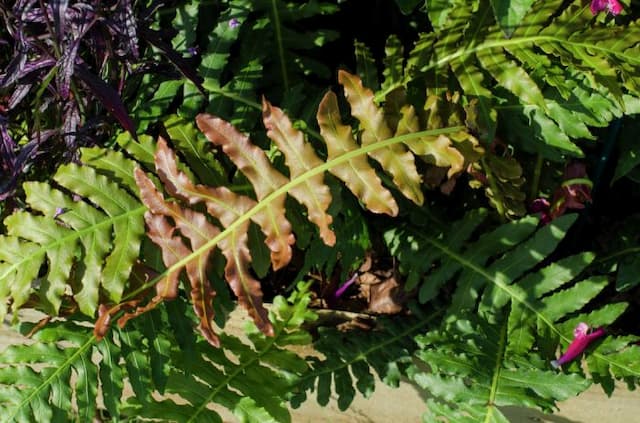
![Dwarf Brazilian tree fern [Eruption]](/_next/image?url=https%3A%2F%2Fplants-admin.emdemapps.com%2Fimages%2Fplants%2F%2Fimages%2F604b5592bbce2.png&w=640&q=75)
